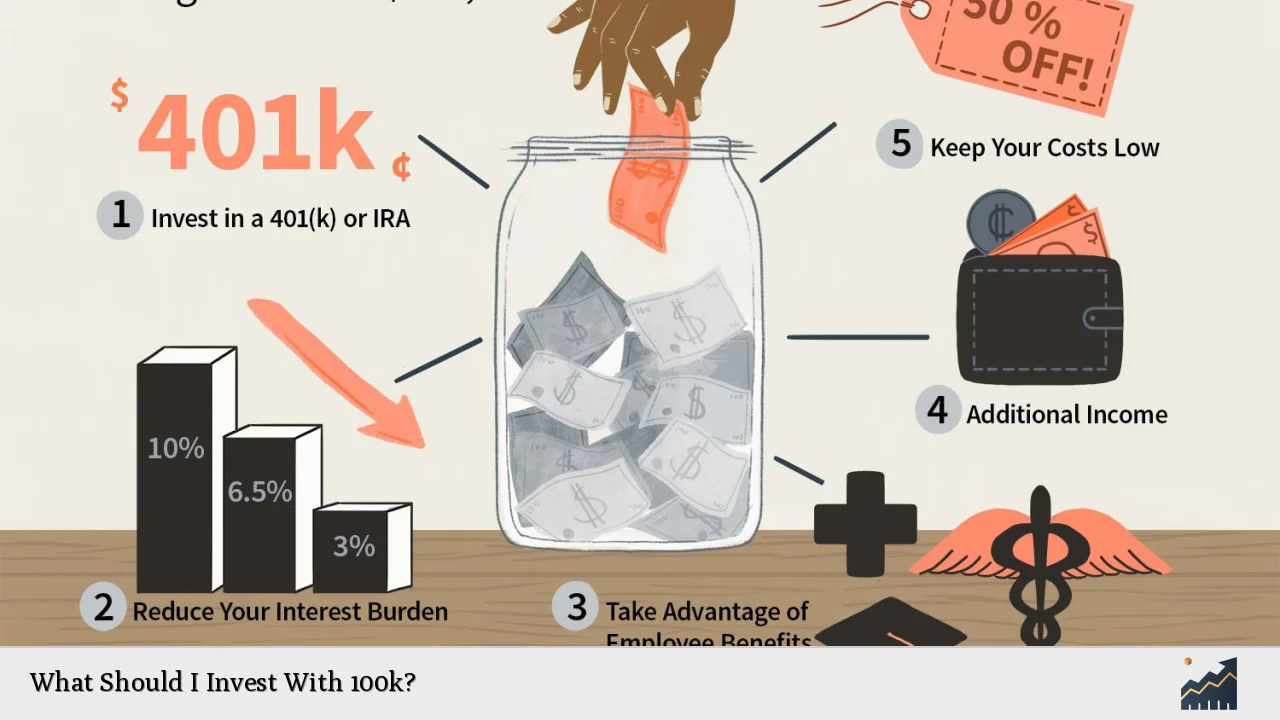Investing $100,000 can be a significant step toward building wealth and achieving financial goals. However, the best investment strategy depends on individual circumstances, including risk tolerance, investment timeline, and financial objectives. With a variety of options available, it’s essential to consider each carefully to maximize returns while managing risks effectively.
Investors can choose from several asset classes such as stocks, bonds, real estate, and alternative investments. Each option comes with its own set of risks and potential rewards. Understanding these can help you make informed decisions about where to allocate your funds.
Here’s a brief overview of common investment options:
| Investment Type | Description |
|---|---|
| Stocks | Equities that represent ownership in a company. |
| Bonds | Debt securities issued by corporations or governments. |
| Real Estate | Physical properties or REITs that generate income. |
| ETFs/Mutual Funds | Pooled investment vehicles that diversify across assets. |
| Alternative Investments | Investments outside of traditional stocks and bonds. |
Understanding Your Investment Goals
Before investing, it is crucial to define your investment goals. Are you looking for long-term growth, short-term gains, or passive income? Knowing your objectives will guide your investment choices.
- Long-term growth: If your goal is to build wealth over time, consider stocks or mutual funds that have a history of strong performance.
- Short-term gains: For those looking to make quick profits, trading in stocks or options might be appealing but comes with higher risk.
- Passive income: Investing in real estate or dividend-paying stocks can provide regular income while still allowing for capital appreciation.
Your risk tolerance also plays a vital role in determining the right investments. Higher potential returns often come with increased risk. Assess how much volatility you can handle without losing sleep at night.
Diversifying Your Portfolio
Diversification is a key strategy in investing. By spreading your investments across various asset classes, you can reduce the overall risk of your portfolio.
- Equities: Consider allocating a portion of your funds to stocks or equity mutual funds. Historically, equities have provided higher returns than other asset classes over the long term.
- Fixed Income: Bonds can stabilize your portfolio during market volatility. They generally offer lower returns than stocks but are less risky.
- Real Estate: Investing in real estate provides both potential appreciation and rental income. You can choose to buy physical properties or invest in Real Estate Investment Trusts (REITs).
- Alternative Investments: These include commodities, hedge funds, and private equity. They can offer unique opportunities but may require more expertise.
A well-diversified portfolio may include:
| Asset Class | Recommended Allocation |
|---|---|
| Stocks | 40-60% |
| Bonds | 20-40% |
| Real Estate | 10-20% |
| Alternatives | 0-10% |
Investing in Stocks
Investing in stocks can be one of the most rewarding ways to grow your wealth over time. Stocks represent ownership in companies and have the potential for high returns through capital appreciation and dividends.
When investing in stocks:
- Research Companies: Look for companies with strong fundamentals and growth potential.
- Consider Index Funds: These funds track specific market indices and provide instant diversification at a low cost.
- Dividend Stocks: These are shares in companies that return profits to shareholders regularly. They provide a steady income stream while also appreciating in value.
The stock market can be volatile; therefore, it’s essential to maintain a long-term perspective and not react impulsively to market fluctuations.
Exploring Real Estate Investments
Real estate is often considered a stable investment option that can provide both cash flow and appreciation over time. Here are some ways to invest:
- Direct Ownership: Purchasing rental properties allows you to earn rental income while benefiting from property value appreciation.
- REITs: Real Estate Investment Trusts allow you to invest in real estate without owning physical property. They provide liquidity and typically pay dividends.
- Flipping Properties: Buying undervalued properties, renovating them, and selling for profit can yield high returns but involves significant risk and effort.
Before diving into real estate investments, consider factors like location, market trends, and property management responsibilities.
Bonds as a Safer Investment
Bonds are often viewed as safer investments compared to stocks. They provide fixed interest payments over time and return the principal at maturity.
When investing in bonds:
- Government Bonds: These are typically considered low-risk investments backed by the government.
- Corporate Bonds: These may offer higher yields but come with increased risk depending on the issuer’s creditworthiness.
- Bond Funds: Investing in bond mutual funds or ETFs allows for diversification among various bonds without needing to manage individual securities.
Bonds are an excellent option for conservative investors looking for stability and regular income.
Alternative Investments
Alternative investments include options beyond traditional stocks and bonds. They can add diversification but often require more research and understanding.
Some popular alternatives include:
- Commodities: Investing in physical goods like gold or oil can hedge against inflation but may be volatile.
- Cryptocurrencies: Digital currencies have gained popularity but come with high volatility and regulatory uncertainty.
- Private Equity: Investing directly in private companies can yield high returns but typically requires significant capital and involves higher risks.
Alternative investments may not be suitable for all investors due to their complexity and illiquidity.
Retirement Accounts
If retirement savings is a priority, consider using part of your $100k to fund retirement accounts like IRAs or 401(k)s. These accounts offer tax advantages that can significantly enhance your savings over time.
When contributing to retirement accounts:
- Maximize Contributions: Aim to contribute the maximum allowed each year to take full advantage of tax benefits.
- Employer Match: If available, contribute enough to receive any employer matching contributions—it’s essentially free money.
Retirement accounts not only help you save for the future but also provide tax-deferred growth on your investments.
FAQs About What Should I Invest With 100k
- What is the best way to invest $100k?
The best way depends on your financial goals; options include stocks, real estate, bonds, or mutual funds. - How can I diversify my $100k investment?
Diversification can be achieved by spreading investments across different asset classes such as equities, bonds, and real estate. - Is it wise to invest all $100k at once?
This depends on market conditions; some prefer dollar-cost averaging to mitigate risks. - What are the risks associated with investing?
The primary risks include market volatility, loss of principal, and liquidity issues depending on the investment type. - Should I consult an advisor before investing?
Yes, consulting a financial advisor can help tailor an investment strategy that aligns with your goals.
In conclusion, investing $100k offers numerous opportunities across various asset classes. By understanding your goals, diversifying effectively, and considering professional advice when necessary, you can develop a robust investment strategy that aligns with your financial aspirations. Always remember that no investment is without risk; thorough research and careful planning are essential for success.

